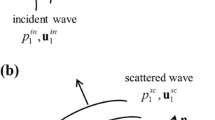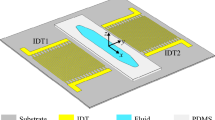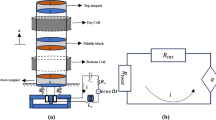Abstract
The Hall thruster exhibits two types of large-scale coherent structures: axially propagating breathing mode (m = 0) and azimuthal, with low m, typically m = 1, spoke mode. In our previous work, it was demonstrated that axial breathing mode can be controlled via the external modulations of the anode potential. Two regimes of the thruster response, linear and nonlinear, have been revealed depending on the modulation amplitude. In this work, using the high-speed camera images and developed image-processing technique, we have investigated the response of the azimuthal mode to the external modulations. We have found that, in linear regime, at low modulation voltages, axial and azimuthal structures coexist. At larger amplitudes, in the nonlinear regime, the azimuthal mode is suppressed, and only axial driven mode remains.














Similar content being viewed by others
REFERENCES
A. Morozov, Plasma Phys. Rep. 29, 235 (2003).
A. Morozov, A. Kislov, and I. Zubkov, JETP Lett. 7, 172 (1968).
A. Morozov, Y. Esipchuk, A. Kapulkin, V. Nevrovskii, and V. Smirnov, Sov. Phys. Tech. Phys. 17, 428 (1972).
A. Morozov, in Proceedings of the 2nd All-Union Conference on Plasma Accelerators, Minsk, 1974, Ed. by A. I. Morozov (Nauka i Tekhnika, Minsk, 1974), Vol. 1, p. 224.
A. I. Morozov, Physical Principles of Space Electric Propulsion Thrusters (Atomizdat, Moscow, 1978) [in Russian].
A. Morozov, in Proceedings of the 23rd International Electric Propulsion Conference, Seattle, WA, 1993, Paper IEPC-93-101.
I. Romadanov, Y. Raitses, and A. Smolyakov, Plasma Sources Sci. Technol. 27, 094006 (2018).
C. Ellison, Y. Raitses, and N. Fisch, Phys. Plasmas 19, 013503 (2012).
C. Ellison, Y. Raitses, and N. Fisch, IEEE Trans. Plasma Sci. 99, 1 (2011).
A. Morozov, V. Nevrovskii, and V. Smirnov, Sov. Phys.-Tech. Phys. 18, 344 (1973).
S. Barral, J. Kaczmarczyk, J. Kurzyna, and M. Dudeck, Phys. Plasmas 18, 083504 (2011).
S. Keller, Y. Raitses, and A. Diallo, in Proceedings of the 50th AIAA/ASME/SAE/ASEE Joint Propulsion Conference, Cleveland, OH, 2014, Paper AIAA 2014-3509.
I. Romadanov, Y. Raitses, A. Diallo, K. Hara, I. Kaganovich, and A. Smolyakov, Phys. Plasmas 25, 033501 (2018).
V. V. Arsenin, High Temp. 8, 1202 (1970).
M. E. Griswold, C. L. Ellison, Y. Raitses, and N. J. Fisch, Phys. Plasmas 19, 053506 (2012).
J. B. Taylor and C. N. Lashmore-Davies, AIP Conf. Proc. 1, 23 (1970).
H. P. Furth and P. H. Rutherford, AIP Conf. Proc. 1, 74 (1970).
V. Arsenin and A. Chuyanov, Sov. Phys. Usp. 20, 736 (1977).
H. Lashinsky and E. Dewan, AIP Conf. Proc. 1, 199 (1970).
J. Fife, M. Martínez-Sánchez, and J. Szaboin, in Proceedings of the 33rd AIAA Joint Propulsion Conference, Seattle, WA, 1997, p. 3052.
A. Morozov and V. Savelyev, in Reviews of Plasma Physics, Ed. by B. B. Kadomtsev and V. D. Shafranov (Consultant Bureau, New York, 2000), Vol. 21, p. 203.
O. Koshkarov, A. Smolyakov, A. Kapulkin, Y. Raitses, and I. Kaganovich, Phys. Plasmas, 25, 061209 (2018).
Y. Esipchuk, A. Morozov, G. Tilinin, and A. Trofimov, Sov. Phys. Tech. Phys. 18, 928 (1974).
A. I. Morozov, in Plasma Accelerators, Ed. by L. A. Artsimovich, S. D. Grishin, G. L. Grozdovskii, L. V. Leskov, A. I. Morozov, A. M. Dorodnov, V. G. Padalka, and M. I. Pergament (Mashinostroenie, Moscow, 1973), p. 85 [in Russian].
J. B. Parker, Y. Raitses, and N. J. Fisch, Appl. Phys. Lett. 97, 091501 (2010).
J. Carlsson, I. Kaganovich, A. Powis, Y. Raitses, I. Romadanov, and A. Smolyakov, Phys. Plasmas 25, 061201 (2018).
S. N. Abolmasov, Plasma Sources Sci. Technol. 21, 035006 (2012).
T. Ito, C. V. Young, and M. A. Cappelli, Appl. Phys. Lett. 106, 254104 (2015).
V. Nevrovskii, PhD Thesis (Kurchatov Institute, Moscow, 1971).
Y. Shi, Y. Raitses, and A. Diallo, Plasma Sources Sci. Technol. 27, 104006 (2018).
Y. Raitses and N. Fisch, Phys. Plasmas 8, 2579 (2001).
A. Smirnov, Y. Raitses, and N. Fisch, J. Appl. Phys. 92, 5673 (2002).
Y. Raitses, A. Smirnov, and N. Fisch, Appl. Phys. Lett. 90, 221502 (2007).
A. Smirnov, Y. Raitses, and N. Fisch, J. Appl. Phys. 94, 852 (2003).
A. Smirnov, Y. Raitses, and N. Fisch, Phys. Plasmas 14, 057106 (2007).
A. Smirnov, Y. Raitses, and N. Fisch, IEEE Trans. Plasma Sci. 36, 2034 (2008).
M. McDonald and A. Gallimore, IEEE Trans. Plasma Sci. 39, 2952 (2011).
M. McDonald, PhD Thesis (University of Michigan, Ann Arbor, MI, 2012).
A. Light, S. Thakur, C. Brandt, Y. Sechrest, G. Tynan, and T. Munsat, Phys. Plasmas 20, 082120 (2013).
ACKNOWLEDGMENTS
This work was supported by DOE. We acknowledge Yuan Shi, Scott Keller, Ahmed Diallo, and Igor Kaganovich for fruitful discussions and Alex Merzhevskiy for his technical support.
Author information
Authors and Affiliations
Corresponding author
Additional information
The article is published in the original.
Appendices
APPENDIX
DETAILS OF THE IMAGE PROCESSING TECHNIQUES
Recorded video can be considered as a 3D matrix of image pixel brightness as a function of position and time,
where x and y are pixel column and row, respectively, and t is a time index. There are three main components of the video, which can be identified by looking at it. The first component is the image from the thruster channel itself and the background plasma, which gives some DC level of intensity. The second is oscillations of the intensity of the whole image due to the breathing mode, or m = 0 mode. The third is the azimuthal oscillations of the intensity due to the rotating spoke, or m = 1 mode, which are of the main interest. To filter these oscillations from the DC level and m = 0 mode several steps were done. Stages of image processing are shown in Fig. 15.
The scheme of image processing includes the following steps.
1. Find external radius Rext of the channel and the anode cup radius Rint. This is done by the MATLAB function “imfindcircles.”
2. Cut frames by the channel size.
3. Calculate mean DC level of all frames over time to obtain the mean image M, defined as
4. Subtract M(x, y) matrix from each frame. Therefore, by subtracting it from each frame the background intensity is eliminated,
5. Apply circular mask on each frame by setting pixel values to zero within Rint and outside Rext.
6. Split each frame on circles Cit with radius ri and width of one pixel, so Rint ≤ ri ≤ Rext, and obtain Rext − Rint arrays of pixels.
7. Calculate average intensity of each circle as
8. Eliminate breathing oscillation effect from each circle by subtracting average intensity ci from each Cit array.
9. Transform each frame to polar coordinates,
10. Because our analysis is focused on identifying the rotational structures, the radial dependence will be neglected. This is accomplished by average pixel intensity along the radius. Therefore, the matrixes Iavg(θ, t) are obtained,
11. Such matrices can be combined along time dimension in so-called 2D “spoke surface.” This surface represents variation of pixel intensity in angular direction θ and with time t.
12. In order to determine characteristic frequencies of azimuthal modes, the 2D Fourier transform was applied to it. The particular implementation is based on the built-in “fft” command in MATLAB. Results are shown in Fig. 16.
(a) Spoke surface. The angled lines correspond to the spoke propagating in azimuthal direction with time. (b) 2D FFT matrix of the spoke surface. This matrix contains a discrete signal for each mode number. One can see that the m = 0 mode is still present even though it was cleaned out of the video. This happens because the breathing mode is much stronger than the azimuthal modes (m = 1).
13. Breathing mode was identified through the Fourier transform of the signal, which was defined as follows:
Rights and permissions
About this article
Cite this article
Romadanov, I., Raitses, Y. & Smolyakov, A. Control of Coherent Structures via External Drive of the Breathing Mode. Plasma Phys. Rep. 45, 134–146 (2019). https://doi.org/10.1134/S1063780X19020156
Received:
Revised:
Accepted:
Published:
Issue Date:
DOI: https://doi.org/10.1134/S1063780X19020156






